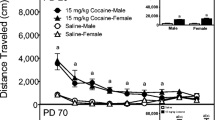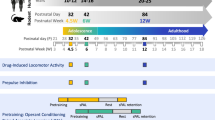Abstract
To achieve a better understanding of the effects on behavioral safety caused by possible neuroprotective doses (50 mg/kg, p.o.) of dextromethorphan HBr (DM), several motor activity measures were monitored in two generations of mice through a long-term period of ten months. Adult male mice (G1), in the presence of DM, developed behavioral tolerance after an initial suppression period. Prenatally exposed, second generation (G2) mice formed two groups, prenatal exposure alone (G2C) and prenatally exposed with additional postnatal exposure (G2T). In the presence of DM, group G2T was characterized by significant behavioral impairment; while G2C exhibited behavioral activation. These results suggest that more attention should be given to the prenatal effects of DM on a developing organism.
Similar content being viewed by others
References Cited
Albers, G. W., Potential therapeutic uses of N-methyl-D-aspartate antagonists in cerebral ischemia.Clinical Neuropharmacology, 13, 177–197 (1990)
Albers, G.W., Saenz, R. and Moses Jr. J. A., Tolerability of oral Dextromethorphan in patient with a history of brain ischemia.Clinical Neuropharmacology, 15, 509–514 (1992).
Bennett, D. A., Bernard, P. S. and Amrick, C. L., A comparison of PCP-like compounds for NMDA antagonism in twoin vivo models.Life Sci., 42, 447–454 (1988).
Boast, C. A. and Pastor, G., Characterization of motor activity patterns induced by N-methyl-D-aspartate antagonists in gerbils.Pharmacol. Biochem. Behav., 27, 553–557 (1987).
Bornstein, S., Czermak, M. and Postel, J., A propes of a case of voluntary drug poisoning with Dextromethorphan HBr.Ann. Med. Psychol., 1, 447–451 (1968).
Cline, H. T., Debski, E. A. and Constantin-Paton, M., N-methyl-D-aspartate receptor antagonist desegregates eye-specific stripes.Proc. Natl. Acad. Sci. USA, 84, 4342–4345, (1987).
Collingridge, G. L. and Bliss, T. V., NMDA receptorstheir role in long-term potentiation.,Trends in Neurosci., 10, 288–293 (1987).
Dodds, A. and Reval, E., Toxic psychosis due to Dextromethorphan.Med. J. Aust., 2, 231 (1967).
Feeser, H. R., Kadis, J. D. and Prince, D. A., Dextromethrophan, a common antitussive, reduces kindled amygdala seizures in the rat.Neurosci. Lett., 86, 340–345 (1988).
Finnegan, K. T., Kerr, J. T. and Langston, J. W., Dextromethorphan protects against the neurotoxic effects of p-chloroamphetamine in rats.Brain Res., 558, 109–111 (1991).
Fleming, P. M., Dependence on Dextromethorphan HBr.Br. Med. J., 293, 597 (1986).
France, C. P., Woods, J. H. and Ornstein, P., The competitive NMDA antagonist CGS 19755 attenuates the rate-decreasing effects of NMDA in rhesus monkeys without producing ketamine-like discrinative effects.Eur. J. Pharmacol., 159, 133–139 (1989).
Goodwin, P. J., Perez, V. J., Eatwell, J. C. Palet, J. C. and Jaworski, M. T., Phencyclidine: Effects of chronic administration in the female mouse on gestation, maternal behavior and the neonates.Psychopharmacol., 69, 63–67 (1980).
Hiramatsu, M., Cho, A. K. and Nabeshima, T., Comparison of the behavior and biochemical effects of the NMDA receptor antagonists, MK-801 and phencyclidine.Eur. J. Pharmacol., 166, 359–366 (1989).
Hutchings, D. E., Bodnarenko, S. R. and Diaz-Deleon, R., Phencycline during pregnancy in the rat: Effects on locomotor activity in the offspring.Pharmacol. Biochem. Behav., 20, 251–254 (1984).
Jasinski, D. R., Martin, W. R. and Manski, P. A., Progress report on the assessment of the antagonist nalbuphine and GPA-2087 for abuse potential and studies of the effects of Dextromethorphan in man.National Academy of Science/National Research Council., 1, 143–178 (1971).
Jhoo, W. K. and Kim, H. C., Drug abuse among korean adolescents.The international congress of applied psychology (Kyoto, Japan). 22, 330 (1990).
Jordan, R. L., Young, T. R., Pinwiddie, S. H. and Harry, G. J., Phencyclidine induced morphological and behavioral alterations in the neonatal rat.Pharmacol. Biochem. Behav. Suppl., 11, 39–45 (1979).
Karler, R. and Calder, L. D., Excitatory amino acids and the actions of cocaine.Brain Res., 582, 143–146 (1992).
Katona, B. and Wason, S., Dextromethorphan danger.New Eng. J. Med., 314, 993 (1986).
Kim, H. C., Pennypacker, K. Bing, G., Bronstein, D., McMillian, M. and Hong, J., The effects of Dextromethorphan on kainic acid-induced seizures in the rat.Neurotoxicol., in press.
Kim, H. C., Kwon, M. S. and Jhoo, W. K., Influence of chronic dextromethorphan administration on cellular immune response in mice.The 43rd Convention of the Pharmaceutical Society of Korea., (1994).
Klinschmidt, A., Bear, M. F. and Singer, W., Blockade of NMDA receptors disrupts experience-dependent plasticity of kitten striate cortex.Science, 238, 355–357 (1987).
Michenfelder, J. D., Lanier, W. R., Scheithauer, B. W., Perkins, W. J., Shearman, G. T. and Milde, J. H., Evaluation of the glutamate antagonist Mk-801 on neurologic outcome in a canine model of complete cerebral ischemia: Correlation with hippocampal histopathology.Brain Res., 481, 228–234 (1989).
Musacchio, J. M., Klain, M. and Canoll, D., Dextromethorphan and sigma ligands: Common sites but diverse effects.Life Sci., 45, 1721–1732 (1989).
Olney, J. W., Labruyere, J. and Price, M. T., Pathological changes induced in cerebrocortical neurons by phencyclidine and related drugs.Science, 244, 1360–1362 (1989).
Orrell, M. and Campbell, P. G., Dependence on Dextromethorphan HBr.Br. Med. J., 293, 1242–1243 (1986).
Rockhold, R. W., Surrett, R. S., Oden, G., Acuff, C. G., Farley, J. M., Zhang, T., Hoskins, B. and Ho, I. K., Inhibition of cocaine intoxification by excitatory amino acid receptor antagonists.Ann N.Y. Acad., 648, 335–337 (1992).
Shaul, W. M., Wandell, M. and Robertson, W. O., Dextromethorphan toxicity: Reversal by Naloxone.Pediatrics, 59, 117–119 (1977).
Tortella, F. C., Ferkany, J. W. and Pontecorbo, M. J., Anticonvulsant effects of dextrorphan in rats: Possible involvement in dextromethorphan-induced seizure protection.Life Sci., 42, 2509–2514 (1988).
Tortella, F. C., Pellicano, M. and Bowery, N. G., Dextromethorphan and neuromodulation: old drug coughs up new activities.Trends in Pharmacol. Sci., 10, 501–507 (1989).
Turski, L. Schwarz, M., Turski, W. A., Klockgether, T., Sontag, K. and Collins, J. F., Muscle relaxant action of excitatory amino acid antagonists.Neurosci. Lett., 53, 321–326 (1985).
Author information
Authors and Affiliations
Rights and permissions
About this article
Cite this article
Kim, HC., Jhoo, WK. Alterations in motor activity induced by high dose oral administration of dextromethorphan throughout two consecutive generations in mice. Arch. Pharm. Res. 18, 146–152 (1995). https://doi.org/10.1007/BF02979186
Received:
Issue Date:
DOI: https://doi.org/10.1007/BF02979186




